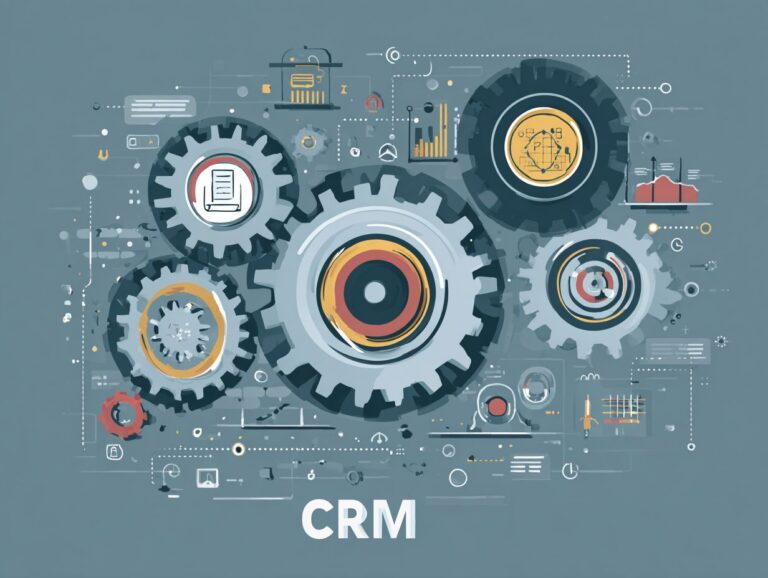How to Integrate CRM? Key Steps for Business Goals
Using customer relationship management (CRM) systems can greatly improve how your business runs. A report from Meta Group, Inc. states that a well-executed CRM system makes tasks easier and typically increases profits for companies.
This article will guide you through the essential steps of the CRM implementation process, revealing how CRM systems can increase efficiency and align with your business goals. Prepare to turn your customer interactions into clear results!
Key Takeaways:
- Know what your business needs before choosing a CRM system to make sure it matches your objectives.
- Organize the integration process with a clear project schedule and specific roles to achieve a smooth and successful change.
- Regularly measure success and ROI through defined KPIs and continuous improvement strategies to make the most out of your CRM integration.
- Assessing Business Needs
- Selecting the Right CRM System
- Planning the Integration Process
- Data Migration Strategies
- Training and Support
- Measuring Success and ROI
- Frequently Asked Questions
- 1. What is CRM and why is it important for businesses?
- 2. How does integrating CRM help achieve business goals?
- 3. What are the key steps for integrating CRM into a business?
- 4. Can any business integrate CRM, or is it only suitable for certain industries?
- 5. How long does it take to fully integrate CRM into a business?
- 6. What are the potential challenges in integrating CRM and how can they be overcome?
1. Importance of CRM for Business Goals

A successful CRM implementation can increase sales productivity by up to 34%, driving better customer engagement and retention. For instance, Salesforce enables teams to track customer interactions seamlessly, ensuring no lead falls through the cracks.
HubSpot, on the other hand, offers user-friendly automation features that allow businesses to nurture leads through targeted email campaigns. A study by XYZ Company showed that after integrating HubSpot, their lead conversion rates soared by 28%.
Organizations can use CRM tools to study customer information, allowing them to adjust their sales methods, improving satisfaction and building long-term connections. Worth exploring: how effective customer experience marketing can boost sales and retention.
2. Overview of Integration Process
The CRM setup process usually includes planning how current business systems will connect and share data smoothly.
- Begin by performing a detailed review of your existing CRM and other tools, like your email marketing or accounting software.
- Use tools like Zapier to move data between platforms without writing code.
- Create a clear system map to visualize how data will flow, identifying potential bottlenecks.
- Get key people involved early by organizing meetings or surveys to cover all requirements and decrease resistance when implementing plans.
- Working together improves the chances of successfully combining efforts and makes operations run much better.
Assessing Business Needs
Knowing what your business needs is essential for choosing the right CRM that matches your goals and improves customer relationships. If you’re looking to maximize your CRM outcomes, examining business consultancy reviews that demonstrate real ROI can provide invaluable insights into optimizing your business strategies.
1. Identifying Key Objectives
Identifying key objectives for your CRM implementation can lead to improved customer retention rates, potentially increasing them by 10-15%.
To set SMART goals, begin by clearly defining your aims, such as “Increase newsletter sign-ups by 20% within six months.” Review your progress weekly to ensure you are on track to meet your goals. Make your objectives achievable; for example, if your current sign-up rate is 100, aim for 120. Make these goals relevant by connecting them to business plans, such as improving how you talk to customers.
Set a clear timeline. Use templates like goal-setting worksheets to write down your goals. This helps you see and track your progress clearly.
2. Understanding Current Systems
Looking at your existing systems closely is important to make sure they work well together and to prevent any problems when setting up the CRM.
Start by doing a SWOT analysis to find out your present strengths, weaknesses, opportunities, and threats related to system integration. Next, assess compatibility by creating a checklist that includes current software, data types, and user processes.
Tools like Lucidchart can help visualize workflows, while a gap analysis will highlight discrepancies between current capabilities and desired outcomes. Plan for a 3-4 hour session so each team member can provide helpful feedback, leading to a more seamless CRM setup.
Selecting the Right CRM System
Choosing the right CRM system is key to achieving your goals. The right features can increase sales and improve customer interactions. Curious about how customer feedback strategies can enhance CRM effectiveness? Our guide explains the key factors.
1. Evaluating Features and Functionality

When looking at CRM features, focus on the functions that affect your customer experience and business tasks. For an effective CRM selection, focus on essential features like lead tracking, analytics, and customer segmentation.
Salesforce provides strong tools for analyzing data and connecting different systems, which help bigger companies. Zoho CRM is affordable and can be customized to meet specific needs, making it a good option for small to medium businesses.
HubSpot stands out for its user-friendly interface and free tier, appealing to startups. Balancing these options with your budget and business size will help you improve customer relationships and simplify processes.
2. Considerations for Scalability
Scalability is a key consideration, as CRM systems must grow alongside your business while maintaining customer success and satisfaction.
For example, HubSpot offers tiered pricing, allowing businesses to start small and upgrade as they expand. Simultaneously, Salesforce offers customizable solutions that fit changing needs, allowing companies like Zocdoc to grow smoothly.
By selecting a CRM like Zendesk that can grow with your business, companies can make sure they always meet customer needs, even as they get bigger. This proactive method improves customer relationships and makes work processes smoother during key growth periods.
Planning the Integration Process
A clear plan for the CRM integration can greatly reduce risks and bring internal team members together for a successful rollout. This approach aligns with the principles outlined in our analysis of the Ultimate Guide To Customer Feedback Strategy.
1. Creating a Project Timeline
Developing a project timeline involves outlining critical phases of the CRM integration, typically spanning 3 to 6 months depending on complexity.
- Start with the planning phase, which usually takes 2-4 weeks. During this time, gather requirements, select the CRM software, and create a project team.
- Next, allocate approximately 1-2 months for data migration, where you’ll clean, map, and import existing data into the new system.
- User training should span 2-3 weeks, focusing on key functionalities and user interfaces.
- Plan for a go-live period of 1 week, followed by post-implementation support to address initial user queries and system adjustments.
2. Assigning Roles and Responsibilities
Clearly defining roles and duties makes people accountable and helps team members work together well during CRM setup.
To improve your CRM project, think about these roles:
- The Project Manager supervises all tasks, making sure deadlines are met and resources are used wisely.
- The Data Analyst collects and examines customer information, helping to improve the system according to what users need.
- The User Support Lead acts as a liaison between the tech team and end-users, addressing concerns and gathering feedback.
Together, these roles form a unified system that improves the CRM’s success and usage throughout the organization.
Data Migration Strategies
Effective data transfer plans are essential for maintaining data accuracy and ensuring a smooth transition to the new CRM system.
1. Cleaning and Preparing Data

Data cleaning and preparation can reduce migration errors significantly, with quality data leading to a 20% increase in CRM effectiveness post-implementation.
To properly prepare data, take these important steps.
- Begin by using OpenRefine to tidy up your data: remove duplicate entries and identify mistakes.
- Next, standardize formats, such as date and currency, to facilitate seamless integration with your new CRM.
- Improve your data by finding and updating missing or old information through more research or by comparing it with trustworthy sources.
These methods improve data accuracy and help your team work together better, improving your CRM system’s performance.
2. Executing Data Transfer
Making sure the data is transferred correctly is important to keep all essential customer information accurate in the new CRM system.
- Start by creating a backup of your existing data to prevent any loss during the transition.
- Tools like Informatica and Fivetran provide strong options for smooth data migration.
- After setting up the migration process, perform a test migration with a small data set to identify any issues.
- Once completed, validate the data in the new system by checking for accuracy and completeness.
- This method makes sure your move is easy and your customer information stays safe.
Training and Support
Creating detailed training programs is important for helping users learn and use the new CRM system easily.
1. Developing Training Programs
A well-designed training plan can increase user engagement by 40%, which is important for effective CRM use.
To create an effective training program, begin by outlining key modules:
- How to Use the System – Show users how to find and use various functions and dashboards.
- Report Generation – Demonstrate how to create and customize reports for analytics.
- Customer Data Management – Share effective methods for entering and keeping correct customer details.
Establish metrics to measure effectiveness, such as post-training quiz scores and user retention rates. Meeting regularly to review feedback can make the program better, ensuring it fits user needs as they change.
2. Providing Ongoing Support
Providing ongoing support after the system is operational can increase user satisfaction and retain customer interest, ensuring the CRM system continues to meet shifting business needs.
Having a specific team for support is important. For example, using Zendesk can sort support tickets, making it easier to follow up on and fix user problems. Integrating Slack provides a platform for real-time communication, enabling team members to share updates and address concerns quickly.
Regular feedback methods, like monthly user surveys or focus groups, help in learning about user experiences and adjusting the CRM as needed. By focusing on these aspects, companies can create a workspace that improves the user experience.
Measuring Success and ROI
Checking how well your CRM system works is important to prove its worth and improve plans moving forward. To truly understand the value it provides, you might find it beneficial to explore one of our most insightful case studies that shows real ROI through business consultancy reviews.
1. Defining Key Performance Indicators (KPIs)

Defining KPIs relevant to CRM can provide clear benchmarks for assessing effectiveness and guiding strategic improvements. Key performance indicators (KPIs) for CRM success include:
- Sales growth
- Customer satisfaction scores
- Response times
For example, a company like XYZ Corp increased its sales by 25% after using a system to gather customer feedback, which raised satisfaction scores by 15%.
By monitoring how long it took to respond, we solved customer problems 30% faster, greatly improving their satisfaction. Programs such as HubSpot or Salesforce allow companies to easily track these KPIs, making sure they align with the company’s goals and change as needed to improve customer relationships.
2. Continuous Improvement Strategies
Using ongoing improvement methods can make CRM systems work better by adjusting to shifts in what customers want and market trends.
To keep getting better over time, use methods such as Agile or Lean. For instance, using Agile sprints allows teams to gather customer feedback quickly, enabling rapid iterations on CRM features. Lean principles focus on cutting waste.
By examining customer behavior, businesses can make operations simpler and provide better service. A real-world example is a SaaS company that improved user retention by 25% after integrating customer feedback loops into their CRM updates. By regularly updating their methods, they made sure their services met changing customer expectations.
Frequently Asked Questions
1. What is CRM and why is it important for businesses?
Customer Relationship Management (CRM) is a technology that helps businesses manage interactions and relationships with customers. It allows businesses to store and analyze customer data, track customer interactions, and improve overall customer experience.
2. How does integrating CRM help achieve business goals?
Integrating CRM into a business’s operations can help achieve various goals, including improving customer relationships, increasing sales and revenue, and streamlining business processes. By gathering and arranging customer information in one place, CRM allows businesses to make better decisions and achieve their objectives.
3. What are the key steps for integrating CRM into a business?
The key steps for integrating CRM into a business include defining business goals, selecting a CRM system, preparing and organizing data, training employees, and continuously monitoring and adjusting the system. It is important to have a clear plan and strategy in place to successfully integrate CRM into a business.
4. Can any business integrate CRM, or is it only suitable for certain industries?
CRM can be beneficial for businesses in a variety of industries, including retail, healthcare, finance, and more. Any business with customers looking to improve how they interact with them and make operations more efficient can benefit from using CRM.
5. How long does it take to fully integrate CRM into a business?
The time it takes to fully integrate CRM into a business can vary depending on the size and complexity of the business, as well as the CRM system being used. Usually, it takes several months to a year to finish bringing everything together. This involves getting data ready, training, and making system changes.
6. What are the potential challenges in integrating CRM and how can they be overcome?
Some potential challenges in integrating CRM may include data compatibility issues, resistance from employees, and the need for continuous system maintenance. These challenges can be managed by careful planning and preparation, offering correct training for employees, and consistently checking and updating the system to keep it working well.





